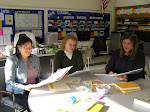When you or your students are creating themselves, the number of readers is of prime consideration. Some times it is determined by the size of a preexisting group. This tends to lend an artificial element to the production but is often unavoidable in classroom situations. Balance and student ability is also a major consideration within the classroom. Because these presentations are often being assessed, fairness dictates this. The material, however, often make this rather difficult, and you may want to devise other way to give each student a fair opportunity to perform.
With narratives involving characters, each reader could represent a difference character, or group of characters, i.e., the townspeople, or audience, or relatives. The reader should read what the character says, thinks and DOES.
If possible, especially if you want your students to think “out of the box,” avoid including a narrator. Have the reader or readers, i.e., a choral reading, most closely related to the descriptive passages read them. Choral reading is difficult, so do not overdo it.
With non-narrative texts or narratives without clearly defined characters, think in terms of concepts. It could be divided by main idea (one reader)/supporting details (other readers) or the division could have to do with geography or time. Even a first person text could be divided: outward statements or actions vs. inner thoughts and feelings.
Feel free to edit the original text.
Monday, March 10, 2008
Subscribe to:
Post Comments (Atom)

No comments:
Post a Comment